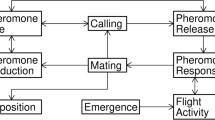Abstract
Twelve models are presented to examine the feasibility of using pheromone baited traps containing chemosterilant for pest control, and to compare the efficiency of this method with the use of (i) pheromone baited traps containing insecticide, and (ii) sterile releases. It was found that the number of matings per individual has little effect on the efficiency of population control, whereas immigration of even a relatively small number of the pest species severely limits this method in its ability to control the population. The existence of density-dependent regulation on the other hand greatly enhances the effectiveness of this control method. If the birth rate greatly exceeds one young per adult per day, then the method using chemosterilants is approximately twice as efficient as either insecticides in the pheromone traps or the release of sterile males. However, if the birth rate is much less than one per day, as in tsetse, then chemosterilants are very much more efficient than either method. These differences in relative efficiency appear to depend on the frequency of mating relative to the birth and mortality rates.
Résumé
On présente douze modèles pour étudier la possibilité d’utiliser des pièges amorcés à phéromones et contenant un chémostérilisant dans la lutte contre les insectes, et pour comparer l’efficacité de cette méthode avec celle de l’utilisation (i) de pièges amorcés à phéromones et contenant un insecticide, et (ii) de libérations d’insectes stériles. On a pu constater que le nombre des accouplements par individu n’a qu’un effet marginal sur l’efficacité de la suppression des populations, alors que l’immigration même d’une nombre relativement restreint de l’espèce en question limite sensiblement l’efficacité de cette méthode. L’existence d’une régulation à partir de la densité augmente au contraire l’efficacité de cette méthode de suppression. Si le taux des naissances dépasse grandement une par adulte par jour, la méthode des chémostérilisants est à peu près deux fois plus efficace que l’utilisation d’insecticides dans les pièges ou la libération de m←es stériles. Mais, si le taux des naissances est beaucoup inférieur à une par jour (c’est le cas des tsé-tsé), les chémostérilisants sont nettement plus efficaces que ces autres méthodes. Ces différences dans l’efficacité relative semblent bien dépendre de la fréquence de l’accouplement par rapport aux taux de naissance et de mortalité.
Similar content being viewed by others
References
Allsopp R., Hall D. and Jones T. (1985) Fatal attraction for the tsetse fly. New Scientist 1481, 40–43.
Barclay H. J. (1981) Population models on the release of chemosterilants for pest control. J. Appl. Ecol. 18, 679–695.
Barclay H. J. (1982) The sterile release method with unequal male competitive ability. Ecol. Modelling 15, 251–263.
Barclay H. J. (1984) Pheromone trapping models for pest control: effects of mating patterns and immigration. Res. Popul. Ecol. 26, 303–311.
Barclay H. J. and Mackauer M. (1980) The sterile insect release method for pest control: a density dependent model. Environ. Entomol. 9, 810–817.
Barclay H. J. and van den Driessche P. (1983) Pheromone trapping models for insect pest control. Res. Popul. Ecol. 25, 105–115.
Barclay H. J. and van den Driessche P. (1984) Pheromone trapping for male annihilation: a density-dependent model. Prot. Ecol. 7, 281–289.
Buxton P. A. (1955) The natural history of tsetse flies. H. K. Lewis, London.
Fisher M. E., van den Driessche P. and Barclay H. J. (1985) A density-dependent model of pheromone trapping. Theor. Popul. Biol. 27, 91–104.
Glasgow J. P. (1963) The distribution and abundance of tsetse. MacMillan Co., New York.
House A. P. R. (1982) Chemosterilization of Glossina morsitans morsitans Westwood and G. pallidipes Austen (Diptera: Glossinidae) in the field. Bull. Entom. Res. 72, 65–70.
Klassen W. and Creech J. F. (1971) Suppression of pest population with sterile male insects. USDA, ARS Misc. Pub. No. 1183, 7 pp.
Knipling. E. F. (1955) Possibilities of insect population control or eradication through the use of sexually sterile males. J. Econ. Entom. 48, 459–462.
Knipling E. F. and McGuire J. U. (1966) Population models to test theoretical effects of sex attractants used for insect control. USDA, ARS, Information Bull. No. 308, 20 pp.
LaBrecque G. C. and Meifert D. W. (1966) Control of house flies (Diptera: Muscidae) in poultry houses with chemosterilants. J. Med. Entom. 3, 232–326.
Langley P. A., Coates T. W., Carlson D. A., Vale G. A. and Marshall J. (1982) Prospects for autosterilization of tsetse flies, Glossina spp. (Diptera: Glossinidae), using sex pheromone and bisazir in the field. Bull. Entom. Res. 72, 319–327.
Langley P. A. and Weidhaas D. (1986) Trapping as a means of controlling tsetse, Glossina spp. (Diptera: Glossinidae): the relative merits of killing and sterilization. Bull. Ent. Res. 76, 89–95.
Marsh R. E. and Howard W. E. (1973) Prospects of chemosterilant and genetic control of rodents. Bull. Wld. Hlth. Org. 48, 309–316.
Nash T. A. M. (1969) Africa’s bane: the tsetse fly. Collins, London.
Pielou E. C. (1969) An introduction to mathematical ecology. Wiley Interscience, New York.
Redfern M. (1986) Tsetse traps stop trypanosomes. New Scientist 1497, 22.
Author information
Authors and Affiliations
Rights and permissions
About this article
Cite this article
Barclay, H.J. Models for Pest Control Using Sex Pheromones and Chemosterilants. Int J Trop Insect Sci 8, 187–196 (1987). https://doi.org/10.1017/S1742758400007207
Received:
Revised:
Published:
Issue Date:
DOI: https://doi.org/10.1017/S1742758400007207




